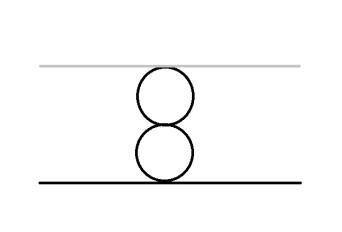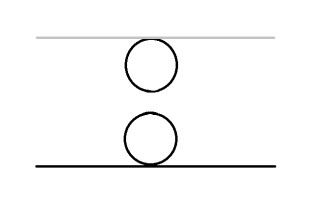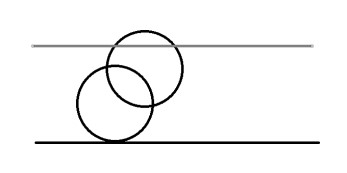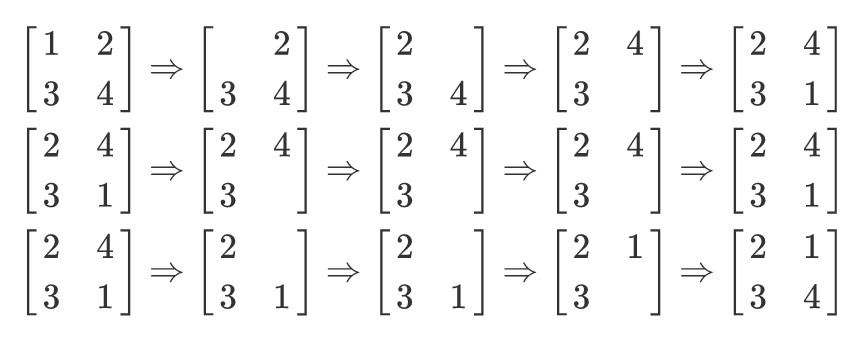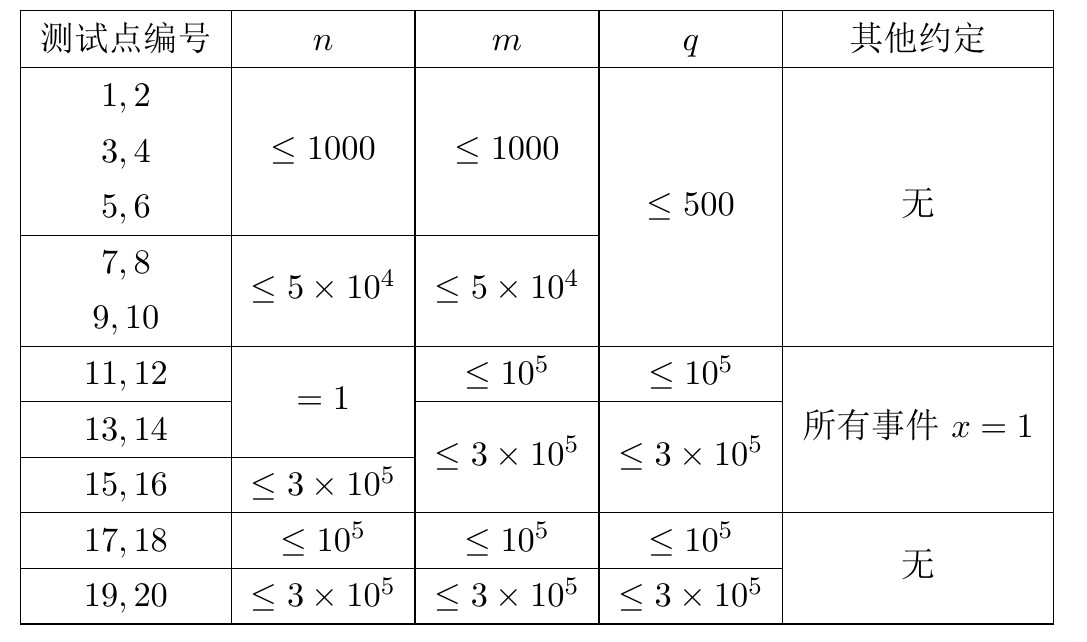前言
NOIp2017已经结束了,由于复赛结束后我没有机会写游记,到这个周末才补上。虽然下个星期期中考
初赛日期2017/10/14,复赛2017/11/11和12,今年还是衢州。本文只包含复赛。
值得一提的是,复赛day1双十一和马拉松,day(-1)和day0是学校秋季运动会,当然我们甚至没机会去看开幕式。
day0
上午有一场两个半小时的模拟赛,题目确实不难,但是我只有230,而很多人都300,没什么信心。
T3给定一棵树,求保留最少的边使得覆盖的点不少于K,由于一条边可以覆盖1或2个点,可以用树形DP或贪心求出最多有几条边可以覆盖2个点,而我却写了二分图匹配,还写错了。还好交了暴力的30分。
12:30我们准时从西门出发,预计三个小时到,最终到四点左右才到达衢州饭店。路上基本也没干什么。
衢州饭店还是比较好的,我们住在三号楼一楼,要走过很长的走廊。矿泉水一个人一小瓶,杯子倒是很多。拖鞋是循环使用的,所以不能带走。我选了靠窗的床,事实证明还是很对的,因为可以方便放东西。无线网不太稳定,反而还是旁边的比较好。
从旅馆到衢州二中堵了很长时间,到学校领袋子,晚饭在学校吃。回去就快多了。晚上看了洛谷模板,包括(下次可以参考)
SSSP
KMP(看完认为还是滚回hash吧)
Dinic(初赛暗示网络流?)
可并堆(还是不太会)
LCA(上午刚写过)
树剖
匈牙利
Tarjan割边割点
Lucas
exgcd(初赛前也看过)
我看了一会儿WARRIORS:Omen of The Stars #6 The Last Hope ,再来一句StarClan, light my path, please. 规划好day1要带的物品后,我们十点多睡觉。
day1
6:20起床,去吃自助餐,并不是很好。我在9号考场,要走不少路才能到,不过去年也一样。
OS是Windows 7,我打开了仪表盘。果然没有Notepad++。
小凯的疑惑(math)
题意
给定$a,b\vert (a,b)=1$,求$ax+by\vert x,y\in\mathbb N$不能表示的最大的数,保证有解。
数据范围
对于30%的数据,$a,b\le50$
对于60%的数据,$a,b\le10,000$
对于100%的数据,$1\le a,b\le10^9$
思路
看到这题我立刻想到了一道USACO的题目,猜想答案应该不大于$ab+a+b$。对于$ax+by=1$,用exgcd求出$x_0,y_0$,然后枚举$c$,解为$cx_0+kb,cy_0-kb$,强制$x\ge0$,如果$y<0$显然无解。不过我不知道复杂度,后来还列出了一个带上取整的不等式,解出的结果只含有$a,b$,但是样例都不对,于是我放弃了。直接从$ab$向下枚举,输出第一个无解的数。好像$a,b\le10^6$都能很快算出。
时间复杂度$\mathcal O(?)$,预计得分60/60+
结束后才知道大部分人都做出了这题,答案是$ab-a-b$。所以我的时间复杂度为$\mathcal O(a+b)$。
代码
1 2 3 4 5 6 7 8 9 10 11 12 13 14 15 16 17 18 19 20 21 22 23 24 25 26 27 28 29 30 31 32 33 34 35 36 37 38 39 40 #include <fstream> #include <algorithm> using namespace std;ifstream fin ("math.in" ) ;ofstream fout ("math.out" ) ;void exgcd (int a, int b, long long &x, long long &y) if (!b) { x = 1 ; y = 0 ; } else { exgcd (b, a % b, y, x); y -= a / b * x; } } int main () int a, b; fin >> a >> b; if (a > b) swap (a, b); long long x, y; exgcd (a, b, x, y); for (long long c = 1ll * a * b; c >= 0 ; c--) { long long k = -x * c / b; if (x * c + 1ll * k * b < 0 ) k++; long long ny = y * c - 1ll * k * a; if (ny < 0 ) { fout << c << endl; return 0 ; } } return 0 ; }
用来对拍的暴力:
1 2 3 4 5 6 7 8 9 10 11 12 13 14 15 16 17 18 19 20 21 22 23 24 25 #include <fstream> using namespace std;ifstream fin ("math.in" ) ;ofstream fout ("math.ans" ) ;int main () int a, b; fin >> a >> b; for (int c = a * b + a + b; c; c--) { bool flag = false ; for (int i = 0 ; i <= c; i += a) if ((c - i) % b == 0 ) { flag = true ; break ; } if (!flag) { fout << c << endl; break ; } } return 0 ; }
时间复杂度(complexity)
题意
给定一个$L$行只含有for 循环的程序,初值和末值可以是常数或$n$,判断其复杂度分析是否正确。可能存在循环不匹配和变量重名错误需要判断。多组数据。
1 2 3 4 5 6 7 8 9 10 11 12 13 14 15 16 17 18 19 20 21 22 23 24 25 26 27 28 29 30 31 32 33 34 8 2 O(1) F i 1 1 E 2 O(n^1) F x 1 n E 1 O(1) F x 1 n 4 O(n^2) F x 5 n F y 10 n E E 4 O(n^2) F x 9 n E F y 2 n E 4 O(n^1) F x 9 n F y n 4 E E 4 O(1) F y n 4 F x 9 n E E 4 O(n^2) F x 1 n F x 1 10 E E
1 2 3 4 5 6 7 8 Yes Yes ERR Yes No Yes Yes ERR
数据范围
对于30%的数据,数据保证小明给出的每个程序的前$L/2$行一定为以F开头的语句,第$L/2+1$行至第$L$行一定为以E开头的语句,$L\le10$。
对于50%的数据,若$x,y$均为整数,$x$一定小于$y$,且只有$y$有可能为$n$。
对于70%的数据,不存在语法错误。
对于100%的数据,$L\le100$。
思路
麻烦的题目,不过我自认为有优势,看起来有点像COWBASIC。$n$和常数怎么判断呢?不过我很快想到了数值法,把很大的数代入$n$,求一下实际复杂度和理论复杂度,如果误差是很小的则认为正确。
接下来的问题在于确定$n$的值。一开始我以为最多有50层循环,后来发现由于字母的限制最多只有25层。一开始我选择了${500,1000}$,后来发现太小了。最终我选择了${10^9,2\times10^9}$,用double 计算。最大误差取$0.01$。
还有表达式计算的问题,我发现每层栈里应该保存该层循环次数和该层累计的数值。
时间复杂度$\mathcal O(L)$,预计得分100
结束后才得知只需要模拟一下,因为每层循环只能执行$0$,$\Theta(1)$或$\Theta(n)$次。注意判断执行$0$次时的问题即可。
代码
很长……调了不少时间
1 2 3 4 5 6 7 8 9 10 11 12 13 14 15 16 17 18 19 20 21 22 23 24 25 26 27 28 29 30 31 32 33 34 35 36 37 38 39 40 41 42 43 44 45 46 47 48 49 50 51 52 53 54 55 56 57 58 59 60 61 62 63 64 65 66 67 68 69 70 71 72 73 74 75 76 77 78 79 80 81 82 83 84 85 86 87 88 89 90 91 92 93 94 95 96 97 98 99 100 101 102 103 104 105 106 107 108 109 110 111 112 113 114 115 116 117 118 119 #include <fstream> #include <string> #include <cstring> #include <sstream> #include <algorithm> #include <cmath> using namespace std;ifstream fin ("complexity.in" ) ;ofstream fout ("complexity.out" ) ;const int N = 105 , vn[] = {1000000000 , 2000000000 };double s[N][2 ], res[2 ];bool vis[26 ];struct line { int opt, l, r; } prog[N]; int str2int (const string &s) stringstream ss (s) ; int x; ss >> x; return x; } double calc (const line &p, int n) int l = p.l, r = p.r; if (l == 1000 ) l = n; if (r == 1000 ) r = n; return max (r - l + 1 , 0 ); } int main () int t; fin >> t; while (t--) { int l; string comp; fin >> l >> comp; memset (vis, 0 , sizeof bool valid = true ; string st; for (int i = 1 ; i <= l; i++) { char opt; fin >> opt; if (opt == 'F' ) { char var; string l, r; fin >> var >> l >> r; if (vis[var - 'a' ]) valid = false ; vis[var - 'a' ] = true ; st += var; prog[i].opt = 1 ; if (l == "n" ) prog[i].l = 1000 ; else prog[i].l = str2int (l); if (r == "n" ) prog[i].r = 1000 ; else prog[i].r = str2int (r); } else { if (st == "" ) valid = false ; else { vis[st[st.length () - 1 ] - 'a' ] = false ; st.erase (st.length () - 1 , 1 ); } prog[i].opt = 2 ; } } if (st != "" ) valid = false ; if (!valid) { fout << "ERR\n" ; continue ; } for (int t = 0 ; t < 2 ; t++) { s[0 ][1 ] = .0 ; int sp = 0 ; for (int i = 1 ; i <= l; i++) if (prog[i].opt == 1 ) { s[++sp][0 ] = calc (prog[i], vn[t]); s[sp][1 ] = .0 ; } else { if (s[sp][1 ] == .0 ) s[sp][1 ] = 1. ; s[sp - 1 ][1 ] += s[sp][0 ] * s[sp][1 ]; sp--; } double th; if (comp == "O(1)" ) th = 1. ; else th = pow (vn[t], str2int (comp.substr (4 , comp.length () - 5 ))); if (s[0 ][1 ] == .0 ) s[0 ][1 ] = 1. ; res[t] = s[0 ][1 ] / th; } if (fabs (1 - res[0 ] / res[1 ]) < 0.01 ) fout << "Yes\n" ; else fout << "No\n" ; } return 0 ; }
逛公园(park)
题意
求有向图中$1->N$长度不超过$d+K$的路径数,其中$d$为$1->N$的最短路长度,可能有0边,如果有无穷条合法路径输出$-1$。多组数据
1 2 3 4 5 6 7 8 9 10 11 12 2 5 7 2 10 1 2 1 2 4 0 4 5 2 2 3 2 3 4 1 3 5 2 1 5 3 2 2 0 10 1 2 0 2 1 0
数据范围
测试点编号
$T$
$N$
$M$
$K$
是否有0边
1
5
5
10
0
否
2
5
1000
2000
0
否
3
5
1000
2000
50
否
4
5
1000
2000
50
否
5
5
1000
2000
50
否
6
5
1000
2000
50
是
7
5
100000
200000
0
否
8
3
100000
200000
50
否
9
3
100000
200000
50
是
10
3
100000
200000
50
是
思路
T2用了较多时间。毫无思路,当然$K=0$就是最短路计数,而$K>0$好像可以用K短路之类的方法。于是我还求了$N$为起点的最短路,然后从$1$开始dfs ,如果当前距离+最短路$>d+K$剪枝。不知道有多少分。
时间复杂度$\begin{cases}\mathcal O((n+m)\log n)&K=0\ \mathcal O(?)&K>0\end{cases}$,预计得分30/30+
代码
这份代码没有包含functional ,在VC++下*std::greater<state>*未定义。
1 2 3 4 5 6 7 8 9 10 11 12 13 14 15 16 17 18 19 20 21 22 23 24 25 26 27 28 29 30 31 32 33 34 35 36 37 38 39 40 41 42 43 44 45 46 47 48 49 50 51 52 53 54 55 56 57 58 59 60 61 62 63 64 65 66 67 68 69 70 71 72 73 74 75 76 77 78 79 80 81 82 83 84 85 86 87 88 89 90 91 92 93 94 95 96 97 98 99 100 101 102 103 104 #include <fstream> #include <queue> #include <algorithm> using namespace std;ifstream fin ("park.in" ) ;ofstream fout ("park.out" ) ;const int N = 100005 , M = 200005 , INF = 1e9 ;int n, m, k, p, head[N], v[M], w[M], nxt[M], e, d[N], f[N];int rhead[N], rv[M], rw[M], rnxt[M], re, rd[N], ans;bool vis[N];inline void add_edge (int u, int v, int w) ::v[++e] = v; ::w[e] = w; nxt[e] = head[u]; head[u] = e; } inline void radd_edge (int u, int v, int w) ::rv[++re] = v; ::rw[re] = w; rnxt[re] = rhead[u]; rhead[u] = re; } void dfs (int u, int dist) if (dist + rd[u] > d[n] + k) return ; if (u == n) { ans = (ans + 1 ) % p; return ; } for (int i = head[u]; i; i = nxt[i]) dfs (v[i], dist + w[i]); } int main () int t; fin >> t; while (t--) { fin >> n >> m >> k >> p; e = re = 0 ; fill (head + 1 , head + n + 1 , 0 ); fill (rhead + 1 , rhead + n + 1 , 0 ); while (m--) { int u, v, w; fin >> u >> v >> w; add_edge (u, v, w); radd_edge (v, u, w); } typedef pair<int , int > state; fill (d + 1 , d + n + 1 , INF); d[1 ] = 0 ; priority_queue<state, vector<state>, greater<state>> Q; Q.push (make_pair (0 , 1 )); fill (f + 1 , f + n + 1 , 0 ); f[1 ] = 1 ; fill (vis + 1 , vis + n + 1 , false ); while (!Q.empty ()) { state k = Q.top (); Q.pop (); if (vis[k.second]) continue ; vis[k.second] = true ; for (int i = head[k.second]; i; i = nxt[i]) if (d[k.second] + w[i] < d[v[i]]) { f[v[i]] = f[k.second]; Q.push (make_pair (d[v[i]] = d[k.second] + w[i], v[i])); } else if (d[k.second] + w[i] == d[v[i]]) (f[v[i]] += f[k.second]) %= p; } if (k == 0 ) fout << f[n] << endl; else { fill (rd + 1 , rd + n + 1 , INF); rd[n] = 0 ; priority_queue<state, vector<state>, greater<state>> Q; Q.push (make_pair (0 , n)); fill (vis + 1 , vis + n + 1 , false ); while (!Q.empty ()) { state k = Q.top (); Q.pop (); if (vis[k.second]) continue ; vis[k.second] = true ; for (int i = rhead[k.second]; i; i = rnxt[i]) if (rd[k.second] + rw[i] < rd[rv[i]]) Q.push (make_pair (rd[rv[i]] = rd[k.second] + rw[i], rv[i])); } ans = 0 ; dfs (1 , 0 ); fout << ans << endl; } } return 0 ; }
剩下的时间
听说很多人都会做T1和T3,大多200+,我感到很绝望,希望T2不要炸。听说T1是小学奥数题,以及有人做过原题。而T3则是“图论算法集合”?
下午没看几页书,晚饭据说从学校打包到旅馆,还必须在员工餐厅里吃,不过zyy好像早跑了。晚上看了一集下午的《自然传奇》,心态好了很多。fks提出敲一下[ZJOI2008]树的统计,他很快就A了,我很害怕没去写,万一真的考了树剖呢。不过吸取一下把int 开成char 的教训。睡得比前一天早。
day2
奶酪(cheese)
题意
一块长宽无限高为$h$的奶酪里有$n$个半径均为$r$的空洞,下表面$z=0$,上表面$z=h$。两个空洞相交或相切可以从一个到达另一个,与表面相交或相切则可以从表面到达空洞。求能否从下表面到达上表面。多组数据
1 2 3 4 5 6 7 8 9 10 3 2 4 1 0 0 1 0 0 3 2 5 1 0 0 1 0 0 4 2 5 2 0 0 2 2 0 4
数据范围
对于20%的数据,$n=1$
对于40%的数据,$n\le8$
对于80%的数据,$h,r,\vert x\vert,\vert y\vert,\vert z\vert\le10,000$
对于100%的数据,$1\le n\le1,000,1\le h,r,\vert x\vert,\vert y\vert,\vert z\vert\le10^9$
思路
计算几何,吃笔记本稳了?分治?不过看到$n\le1,000,T\le20$就很简单了,不就是直接bfs 。注意一下long long 应该就可以了吧。不会卡常吧?
时间复杂度$\mathcal O(Tn^2)$,预计得分100
果然那么简单还是有陷阱的,$(2\times10^9)^2\times3=12\times10^{18}>2^{63}$!所以要unsigned long long 或者把左边的一项移到不等式右边。只有80了。
让我欣慰的是,有人直接用浮点数开根,可能被卡常,还有人用了int ……另外据说$z\ge0$。
代码
1 2 3 4 5 6 7 8 9 10 11 12 13 14 15 16 17 18 19 20 21 22 23 24 25 26 27 28 29 30 31 32 33 34 35 36 37 38 39 40 41 42 43 44 45 46 47 48 49 50 51 52 53 54 55 56 57 58 #include <fstream> #include <queue> #include <algorithm> using namespace std;ifstream fin ("cheese.in" ) ;ofstream fout ("cheese.out" ) ;const int N = 1005 ;int x[N], y[N], z[N];bool vis[N];inline long long sqr (long long x) return x * x; } int main () int t; fin >> t; while (t--) { int n, h, r; fin >> n >> h >> r; queue<int > Q; for (int i = 1 ; i <= n; i++) { fin >> x[i] >> y[i] >> z[i]; if (abs (z[i]) <= r) { vis[i] = true ; Q.push (i); } else vis[i] = false ; } while (!Q.empty ()) { int k = Q.front (); Q.pop (); for (int j = 1 ; j <= n; j++) if (!vis[j] && sqr (x[k] - x[j]) + sqr (y[k] - y[j]) + sqr (z[k] - z[j]) <= 4 * sqr (r)) { vis[j] = true ; Q.push (j); } } bool ans = false ; for (int i = 1 ; i <= n; i++) if (vis[i] && abs (z[i] - h) <= r) { ans = true ; break ; } if (ans) fout << "Yes\n" ; else fout << "No\n" ; } return 0 ; }
宝藏(treasure)
题意
给定一张无向图,需要选定一个点$s$,每条边的代价$c_i=w_i\times(\min(dist_{s,u_i},dist_{s,v_i})+1)$,求生成树最小代价和。
1 2 3 4 5 6 4 5 1 2 1 1 3 3 1 4 1 2 3 4 3 4 1
数据范围
对于20%的数据,保证输入是一棵树
对于40%的数据,所有$w_i$相等
对于70%的数据,$n\le8,w_i\le5,000$
对于100%的数据,$1\le n\le12,0\le m\le1,000,w_i\le500,000$
思路
重边显然取min,这样边数只有$\frac{n(n-1)}2$,但好像基于边比较难做。似乎暴力也很难写,但我yy出了一种奇怪的做法:类似Prim,每次选择一个不在生成树中的点加入,更新最短路,然后继续搜。具体见代码。如果无解怎么办?
时间复杂度$\mathcal O(n^3n!)$,预计得分70
应该是状压DP,还有人写了多项式复杂度的贪心。
代码
1 2 3 4 5 6 7 8 9 10 11 12 13 14 15 16 17 18 19 20 21 22 23 24 25 26 27 28 29 30 31 32 33 34 35 36 37 38 39 40 41 42 43 #include <fstream> #include <algorithm> using namespace std;ifstream fin ("treasure.in" ) ;ofstream fout ("treasure.out" ) ;const int N = 15 , INF = 1e9 ;int n, m, mat[N][N], d[N], ans;void dfs (int k, int now) if (now > ans) return ; if (k == n) ans = now; for (int i = 1 ; i <= n; i++) if (d[i] < INF) for (int j = 1 ; j <= n; j++) if (mat[i][j] && d[j] == INF) { d[j] = d[i] + 1 ; dfs (k + 1 , now + mat[i][j] * (d[i] + 1 )); d[j] = INF; } } int main () fin >> n >> m; while (m--) { int u, v, w; fin >> u >> v >> w; if (!mat[u][v] || w < mat[u][v]) mat[u][v] = mat[v][u] = w; } ans = INF; for (int i = 1 ; i <= n; i++) { fill (d + 1 , d + n + 1 , INF); d[i] = 0 ; dfs (1 , 0 ); } fout << ans << endl; return 0 ; }
列队(phalanx)
题意
给定一个$n\times m$的矩阵$A$,$A_{i,j}=(i-1)m+j$。$q$次操作($n,m,q\le3*10^5$),每次删除一个位置$(x,y)$,然后将第$x$行向左补齐,再将第$m$列向前补齐,最后在$A_{n,m}$填上删除的数。求每次删除的数。
数据范围
思路
果然有数据结构题,然而并不会做。不过部分分很丰富,有点天天爱跑步的感觉。
前30%直接暴力,而50%比较有趣,$q\le500$,远小于矩阵规模,可见很多行除第$m$列外根本不会变。那么可以在每次询问时如果$x$行第一次出现,暴力构建,再进行操作,当然也要维护第$m$列的数。每行的数据可以用一个指针数组或者std::vector 记录。
再考虑$n=1$的情况,问题简化为一个数列,每次删除一个数,把它放在最后。随机访问的链表?好像不太对。不过如果不删除数,只是简单的打标记$flag_y$,然后最后新增,问题就转换为求第一个$i\vert i-\sum_{j=1}^i flag_j=y$,显然可以二分。前缀和可以用树状数组维护,$\log^2 n$,如果线段树树上二分可以做到$\log n$,完美解决。具体实现时,发现不必写递归版的线段树,非递归的更简单。
如果只有$x=1$,发现只要用队列维护第$m$列即可。
好像输入输出很大,想到模拟赛fstream 被卡常的经历,我还写了输入输出优化。
时间复杂度$\begin{cases}\mathcal O(q\log m)&x=1\ \mathcal O((n+m)q)&\text{otherwise}\end{cases}$,预计得分80
代码
1 2 3 4 5 6 7 8 9 10 11 12 13 14 15 16 17 18 19 20 21 22 23 24 25 26 27 28 29 30 31 32 33 34 35 36 37 38 39 40 41 42 43 44 45 46 47 48 49 50 51 52 53 54 55 56 57 58 59 60 61 62 63 64 65 66 67 68 69 70 71 72 73 74 75 76 77 78 79 80 81 82 83 84 85 86 87 88 89 90 91 92 93 94 95 96 97 98 99 100 101 102 103 104 105 106 107 108 109 110 111 112 113 114 115 116 117 118 119 120 121 122 123 124 125 126 #include <cstdio> #include <cctype> #include <queue> using namespace std;const int N = 50005 , N2 = 600005 , SZ = 1e6 ;unsigned last[N], *a[N];int tree[N2 * 4 ];long long val[N2];FILE *fin = fopen ("phalanx.in" , "r" ), *fout = fopen ("phalanx.out" , "w" ); char ibuf[SZ], *ip = ibuf, *iend = ibuf, obuf[SZ], *op = obuf, *oend = obuf + SZ;inline char nextchar () if (ip == iend) { iend = ibuf + fread (ibuf, 1 , SZ, fin); ip = ibuf; } return *ip++; } inline void nextchar (char c) if (op == oend) { fwrite (obuf, 1 , SZ, fout); op = obuf; } *op++ = c; } template <typename Int>inline void read (Int &x) char c; for (c = nextchar (); isspace (c); c = nextchar ()) ; x = 0 ; for (; isdigit (c); c = nextchar ()) x = x * 10 + c - '0' ; } int dig[20 ];template <typename Int>inline void writeln (Int x) int len = 0 ; do dig[++len] = x % 10 ; while (x /= 10 ); for (; len; len--) nextchar (dig[len] + '0' ); nextchar ('\n' ); } int main () int n, m, q; read (n); read (m); read (q); if (n <= 5e4 && m <= 5e4 && q <= 500 ) { for (int i = 1 ; i <= n; i++) last[i] = 1u * i * m; while (q--) { int x, y; read (x); read (y); if (!a[x]) { a[x] = new unsigned [m + 1 ]; for (int i = 1 ; i < m; i++) a[x][i] = 1u * (x - 1 ) * m + i; } a[x][m] = last[x]; unsigned tmp = a[x][y]; for (int i = y + 1 ; i <= m; i++) a[x][i - 1 ] = a[x][i]; for (int i = x + 1 ; i <= n; i++) last[i - 1 ] = last[i]; last[n] = tmp; writeln (tmp); } for (int i = 1 ; i <= n; i++) if (a[i]) delete [] a[i]; } else { queue<long long > last; for (int i = 1 ; i <= n; i++) last.push (1ll * i * m); for (int i = 1 ; i <= m; i++) val[i] = i; for (int t = 1 ; t <= q; t++) { int x, y; read (x); read (y); int id = 1 , l = 1 , r = m + q, sum = 0 ; while (l < r) { int mid = (l + r) / 2 ; if (mid - tree[id * 2 ] - sum >= y) { r = mid; id *= 2 ; } else { sum += tree[id * 2 ]; l = mid + 1 ; id = id * 2 + 1 ; } } long long tmp = val[l]; tree[id] = 1 ; while (id > 1 ) tree[id /= 2 ]++; last.pop (); last.push (tmp); val[m + t] = last.front (); writeln (tmp); } } fwrite (obuf, 1 , op - obuf, fout); return 0 ; }
剩下的时间
我感觉day2比day1简单,听说不少人T1出现了一些偏差。而T3我也很高兴拿了这么多部分分。快到时,选手程序已经公开,cfb在洛谷上交他的程序,车上气氛活跃。大约16点回到学校西门。
我们去机房交自己的程序,看洛谷的数据。我手忙脚乱的改输入输出,还CE了一次。所幸我的成绩没有太大的偏差,反而高了。洛谷比赛结束时有3.4K用户参加排名,其中有45个AK。
几天后
洛谷455,绍一490,学军420,波动比较大。不过据说洛谷的分数比较准确。
初测440,浙江省Rank125,学校Rank18,年段第六。浙江一等奖分数线据说大约395。
math
complex
park
cheese
treasure
phalanx
总分
60
100
30
100
70
80
440
浙江省分数线360,共305人获奖,大约53%……因为特派员已经被提高了5分……
按照公式有理有据,自从历年一等奖不占名额后,一等奖人数大幅增加。明年350人应该没问题了。
